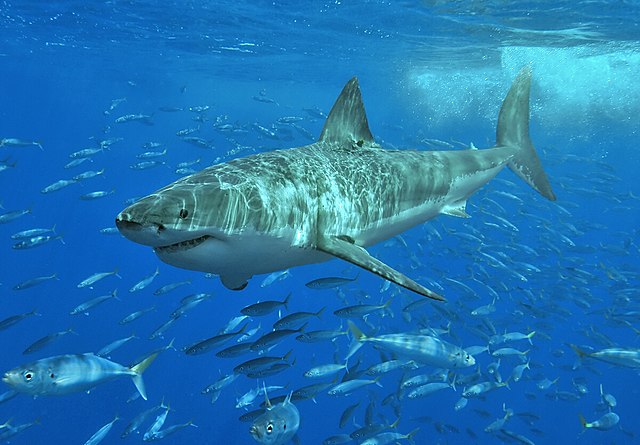The Impact of “Jaws” on Sharks
The origins of the film, its unrealistic depictions of sharks, and its legacy in the 21st century
Terry Goss, CC BY-SA 3.0
“Jaws” has caused many to fear the water, but according to a study by the International Shark Attack File, the risk of death as a result of a shark is 1 in 3,748,067. A person is more likely to be struck by lightning.
Duuun dun…Duuun dun…Duuun dun…dun dun dun dun dun dun!
Almost everyone knows the famous soundtrack of the movie Jaws, filling audiences with dread and delight as the foreboding music begins to play. But what is lesser known is the harmful impact the summer blockbuster had on public perception of sharks. In 1975, the film’s release skyrocketed director Steven Spielberg to fame after adapting the book Jaws by Peter Benchley. Combined with the thrilling score composed by John Williams, Jaws was an instant hit becoming the highest-grossing film in history before the release of Star Wars: A New Hope two years later. The next year, the film was nominated for Best Picture and won three other Oscars in 1976.

The release of Jaws not only ushered in a new era of moviemaking but also shark hysteria. Set on the fictional beach town of Amity Island off the coast of New England, summaries of the movie describe the shark as a “blood-thirsty beast” that “terrorizes” innocent beach goers. With sparse information on sharks in the 1970s, the unrealistic depiction of the shark behavior let audiences’ imaginations run wild.
The movie’s structure fosters a sense of suspense and fear, as viewers do not see the shark until over an hour into the film. Only after multiple attacks that proved fatal does the shark make an appearance. The late reveal further distances the audience from the shark, both visually and emotionally, allowing the film to depict shark behavior unrealistically.
Many scenes depict swimmers fighting to stay above water in vain as the shark pulls them below and blood washes onto the shore. In an interview with Scientific American, Greg Skomal, a shark expert at the Massachusetts Division of Marine Fisheries, explains why this depiction is misleading: “The white shark in the film was far larger than normal—about 25 feet—while the largest animals in the wild are typically 15 to 18 feet…They had it satisfying hunger by consuming humans. They don’t do that. White sharks did not evolve with humans as prey or food.”
Of course, the movie Jaws cannot be blamed alone for the problems facing sharks today. The practice of shark finning and increasing impacts of climate change, for instance, are factors that exist outside of the film’s control and continue to harm sharks. However, Jaws did shape generations’ perceptions of sharks. And while some walked away with a negative view, many also credit the movie with sparking their interest in sharks and marine biology. After the 46th anniversary of the movie this summer, shark conservation is beginning to gain more attention and over the years, a new narrative has begun to emerge.
The author of Jaws, Peter Benchley, later regretted villainizing sharks in his book that inspired the classic film. Before his passing in 2006, Benchley sought to help undo this narrative through conservation work for the Environmental Defense Fund and WildAid. Benchley also traveled the world to advocate against shark finning. His widow, Wendy Benchley, continues to be a part of this effort and in a statement to The New York Times, expressed hope that the message of both the book and film has evolved: “Maybe when Jaws first came out people were scared of the water. But the next generation found a great adventure story, and many of them wanted to learn about the ocean.”




